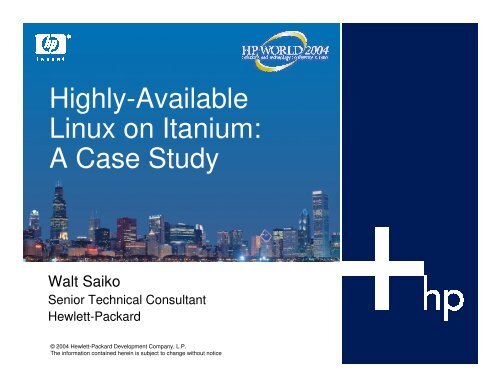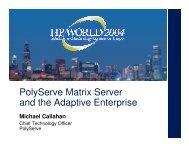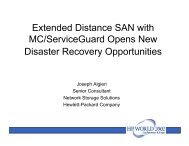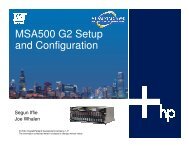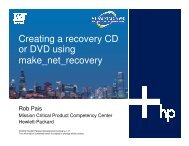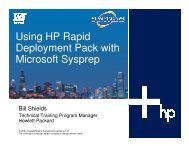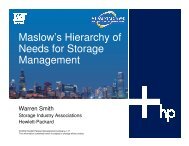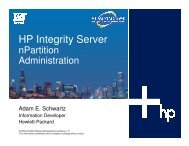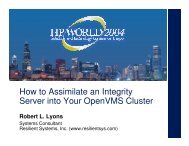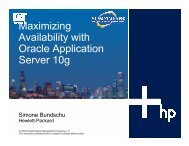Highly Available Linux on Itanium: A Case Study of How ... - OpenMPE
Highly Available Linux on Itanium: A Case Study of How ... - OpenMPE
Highly Available Linux on Itanium: A Case Study of How ... - OpenMPE
You also want an ePaper? Increase the reach of your titles
YUMPU automatically turns print PDFs into web optimized ePapers that Google loves.
<str<strong>on</strong>g>Highly</str<strong>on</strong>g>-<str<strong>on</strong>g>Available</str<strong>on</strong>g><br />
<str<strong>on</strong>g>Linux</str<strong>on</strong>g> <strong>on</strong> <strong>Itanium</strong>:<br />
A <strong>Case</strong> <strong>Study</strong><br />
Walt Saiko<br />
Senior Technical C<strong>on</strong>sultant<br />
Hewlett-Packard<br />
© 2004 Hewlett-Packard Development Company, L.P.<br />
The informati<strong>on</strong> c<strong>on</strong>tained herein is subject to change without notice
agenda<br />
• Introducti<strong>on</strong><br />
• Sessi<strong>on</strong> Is / Sessi<strong>on</strong> Is Not<br />
• Overview <strong>of</strong> Serviceguard<br />
• Serviceguard for <str<strong>on</strong>g>Linux</str<strong>on</strong>g> <strong>on</strong> <strong>Itanium</strong><br />
• Trade<strong>of</strong>fs <strong>of</strong> Supported <str<strong>on</strong>g>Linux</str<strong>on</strong>g> Distributi<strong>on</strong>s<br />
• <strong>Case</strong> <strong>Study</strong><br />
− Challenge<br />
− Alternatives<br />
− Soluti<strong>on</strong><br />
2
introducti<strong>on</strong> - biography<br />
• Ten years with HP<br />
• Five years as HP customer<br />
• Senior Technical C<strong>on</strong>sultant<br />
• Degrees:<br />
− BS Computer Science<br />
− MS Computer Science<br />
− MBA<br />
• 15 years Unix experience<br />
• 10 years high availability focus<br />
3
introducti<strong>on</strong> - my roles within HP<br />
• HP Technology Soluti<strong>on</strong>s Group<br />
− Partner Technology Access Center (PTAC)<br />
• Work exclusively with Independent S<strong>of</strong>tware<br />
Vendors (ISVs)<br />
• Ensure that their applicati<strong>on</strong>s perform best <strong>on</strong> the<br />
HP platform (HP-UX, <str<strong>on</strong>g>Linux</str<strong>on</strong>g>, PA-RISC, <strong>Itanium</strong>)<br />
4
introducti<strong>on</strong> – PTAC services<br />
• Delivery <strong>of</strong> Free Services to ISVs, including:<br />
− High Availability Implementati<strong>on</strong> & Validati<strong>on</strong><br />
− Applicati<strong>on</strong> Performance Analysis & Tuning<br />
− Compiler Optimizati<strong>on</strong><br />
− Applicati<strong>on</strong> Porting & Migrati<strong>on</strong><br />
− Applicati<strong>on</strong> Pr<strong>of</strong>iling and Sizing<br />
5
point <strong>of</strong> clarificati<strong>on</strong><br />
• <strong>Itanium</strong> = <strong>Itanium</strong>2 = IPF = Integrity<br />
6
prerequisites<br />
• System administrati<strong>on</strong> experience<br />
• Network experience<br />
• Serviceguard knowledge<br />
• <str<strong>on</strong>g>Linux</str<strong>on</strong>g> knowledge<br />
• HP-UX knowledge<br />
• Understanding <strong>of</strong> issues surrounding high<br />
availability<br />
7
sessi<strong>on</strong> is NOT:<br />
• Sales pitch for Serviceguard<br />
• Sales pitch for HP hardware<br />
• Tutorial <strong>on</strong> <str<strong>on</strong>g>Linux</str<strong>on</strong>g>/Open Source/High Availability<br />
• Tutorial <strong>on</strong> HP’s Serviceguard<br />
• Recommendati<strong>on</strong> <strong>of</strong> <strong>on</strong>e distributi<strong>on</strong> <strong>of</strong> <str<strong>on</strong>g>Linux</str<strong>on</strong>g> over<br />
another<br />
• Comparis<strong>on</strong>/c<strong>on</strong>trast <strong>of</strong> high availability soluti<strong>on</strong>s<br />
<strong>on</strong> <str<strong>on</strong>g>Linux</str<strong>on</strong>g> and HP-UX<br />
8
sessi<strong>on</strong> IS:<br />
• Overview <strong>of</strong> Serviceguard for <str<strong>on</strong>g>Linux</str<strong>on</strong>g> <strong>on</strong> <strong>Itanium</strong><br />
• Examinati<strong>on</strong> <strong>of</strong> <strong>on</strong>e company’s effort to build a highlyavailable<br />
implementati<strong>on</strong> <strong>of</strong> a <str<strong>on</strong>g>Linux</str<strong>on</strong>g> applicati<strong>on</strong> <strong>on</strong> HP<br />
hardware<br />
• Steps taken to provide a highly-available applicati<strong>on</strong><br />
envir<strong>on</strong>ment for this ISV<br />
• Issues faced<br />
• Alternatives c<strong>on</strong>sidered<br />
• Decisi<strong>on</strong>s reached<br />
• Soluti<strong>on</strong> built<br />
• Less<strong>on</strong>s learned<br />
9
Overview <strong>of</strong> Serviceguard<br />
functi<strong>on</strong>ality…
hp Serviceguard<br />
• No fault tolerance, no load balancing<br />
cluster<br />
• M<strong>on</strong>itors hardware & s<strong>of</strong>tware<br />
resources<br />
• Requires redundant hardware<br />
comp<strong>on</strong>ents (no SPOF)<br />
• Runs <strong>on</strong> standard hardware and<br />
operating systems<br />
• Integrati<strong>on</strong> <strong>of</strong> applicati<strong>on</strong>s without any<br />
modificati<strong>on</strong><br />
• More than 80,000 licenses sold (HP-<br />
UX & <str<strong>on</strong>g>Linux</str<strong>on</strong>g>)<br />
• Supports local, campus, metropolitan<br />
and c<strong>on</strong>tinental<br />
c<strong>on</strong>figurati<strong>on</strong>s<br />
11
terminology<br />
= node<br />
= package = cluster<br />
12
package definiti<strong>on</strong><br />
A package defines all resources required to run an<br />
applicati<strong>on</strong> or part <strong>of</strong> an applicati<strong>on</strong> <strong>on</strong> a cluster node.<br />
Package Definiti<strong>on</strong><br />
Resources:<br />
• nodes<br />
• network & IP addresses<br />
• volume groups<br />
Services:<br />
• real services (processes)<br />
• virtual services (scripts)<br />
• start/stop scripts<br />
• …<br />
13
package definiti<strong>on</strong> (c<strong>on</strong>tinued)<br />
IP Address :<br />
disk space :<br />
15.128.129.130 <strong>on</strong> subnet 15.136.129.0<br />
VG=vg01 LV=/dev/vg01/lvol1 FS=/appl1<br />
LV=/dev/vg02/lvol1 FS=/appl2<br />
processes (via services):<br />
applicati<strong>on</strong> process 1<br />
applicati<strong>on</strong> process 2<br />
middleware processes<br />
m<strong>on</strong>itoring scripts<br />
start & stop scripts<br />
14
storage c<strong>on</strong>figurati<strong>on</strong><br />
The Nodes <strong>of</strong> a Cluster share storage via multi initiator SCSI buses<br />
or fiber channel infrastructure.<br />
A B C<br />
A B C<br />
15
local LAN switch<br />
Fast and transparent switch <strong>of</strong><br />
complete TCP/IP stack to standby<br />
interface – no client rec<strong>on</strong>nect required<br />
IP A<br />
Node A<br />
A<br />
IP A<br />
Node A<br />
A<br />
16
package switch<br />
Packages act as virtual hosts, moving<br />
relocatable ip addresses to hosting<br />
node and activating volume groups,<br />
start applicati<strong>on</strong> and services<br />
IP A<br />
A<br />
Node A<br />
Node B<br />
A<br />
A<br />
A<br />
IP A<br />
shared disks<br />
Node A<br />
A<br />
Node B<br />
shared disks<br />
17
e-locatable IP address(es)<br />
Bridge<br />
Stati<strong>on</strong>ary IP:<br />
192.6.3.35<br />
Standby<br />
LAN<br />
Stati<strong>on</strong>ary IP:<br />
192.6.3.36<br />
Standby<br />
LAN<br />
LAN FAILURE<br />
Relocatable IP:<br />
192.6.3.88<br />
Pkg<br />
• Local IP relocati<strong>on</strong> minimizes downtime<br />
• IP at package level enables fail over to<br />
multiple nodes minimizing performance<br />
impact<br />
18
cluster failure detecti<strong>on</strong><br />
− Node failures<br />
• Operating system panics<br />
• Hardware failures<br />
• Pause failures (hangs)<br />
− Network failures<br />
• Interface card failure<br />
• Cable disc<strong>on</strong>necti<strong>on</strong><br />
• Loss <strong>of</strong> terminati<strong>on</strong><br />
− Service failures<br />
• Processes failure or<br />
terminati<strong>on</strong><br />
Service<br />
Failure<br />
Node 1<br />
Network Failure<br />
Node<br />
Failure<br />
A<br />
Pkg A<br />
Node 2<br />
Service<br />
2 – 37 19
node failure<br />
<br />
<br />
<br />
<br />
<br />
<br />
<br />
<br />
<br />
<br />
<br />
<br />
2 – 38 20
split brain situati<strong>on</strong><br />
Cluster services cannot communicate any more both nodes try to take<br />
all cluster packages<br />
21
cluster lock<br />
• Serviceguard was designed to prevent split brain by using <strong>on</strong>e<br />
<strong>of</strong> the following cluster lock (or tie breaking) methods:<br />
− cluster lock lun<br />
− quorum server<br />
22
cluster lock quorum server<br />
• The QS is not running <strong>on</strong> a cluster member node.<br />
• QS uses TCP/IP, and it listens at a known port (1238) for<br />
c<strong>on</strong>necti<strong>on</strong> requests from the Serviceguard (SG) nodes<br />
• QS machine can be used to run other applicati<strong>on</strong>s besides QS<br />
• QS can run as a SG package in <strong>on</strong>e cluster to provide tiebreaking<br />
service for another SG cluster. Do not use reciprocal<br />
packages<br />
• A single QS can be used as a cluster lock for multiple clusters.<br />
Maximum number <strong>of</strong> clusters supported is 50 and the total<br />
number <strong>of</strong> nodes supported is 100.<br />
• Heterogenous c<strong>on</strong>figurati<strong>on</strong>s are supported (HP-UX and <str<strong>on</strong>g>Linux</str<strong>on</strong>g>)<br />
• The QS must be present at cluster c<strong>on</strong>figurati<strong>on</strong> time<br />
(cmapplyc<strong>on</strong>f)<br />
• The QS must be present at cluster reforming time, when<br />
remaining nodes cannot build a quorum (less/equal 50% <strong>of</strong><br />
nodes)<br />
• QS is required for 2 node clusters, opti<strong>on</strong>al for 3 to 16 node<br />
clusters<br />
23
cluster lock lock lun<br />
• Serviceguard for <str<strong>on</strong>g>Linux</str<strong>on</strong>g> supports a cluster lock LUN<br />
− <str<strong>on</strong>g>Available</str<strong>on</strong>g> starting with SG/LX versi<strong>on</strong> A.11.15<br />
− Supported for 2 to 4 node clusters<br />
− C<strong>on</strong>figured <strong>on</strong> a shared lun with a <str<strong>on</strong>g>Linux</str<strong>on</strong>g> partiti<strong>on</strong> <strong>of</strong> 100k in size<br />
− This 100k lock LUN partiti<strong>on</strong> cannot be used for applicati<strong>on</strong> data<br />
24
quorum service arbitrati<strong>on</strong><br />
node 1<br />
node 2<br />
quorum service<br />
LINUX<br />
pkg2<br />
HA<br />
s<strong>of</strong>tware<br />
Hub<br />
• Ensures data integrity<br />
• 50 heterogeneous <str<strong>on</strong>g>Linux</str<strong>on</strong>g> clusters or 100<br />
nodes supported by <strong>on</strong>e QS<br />
B<strong>on</strong>ding (<str<strong>on</strong>g>Linux</str<strong>on</strong>g>) can be c<strong>on</strong>figured<br />
<strong>on</strong> the QS for additi<strong>on</strong>al<br />
redundancy<br />
25
cluster lock LUN<br />
node 1<br />
Shared<br />
Storage<br />
node 2<br />
Pkg 1<br />
Pkg 2<br />
Cluster Lock LUN<br />
• Alternative to QS<br />
• Can be c<strong>on</strong>figured with SCSI or<br />
Fiber channel storage<br />
Hub/SW<br />
Heartbeat Link<br />
Client<br />
C<strong>on</strong>necti<strong>on</strong>s<br />
Hub/SW<br />
Heartbeat/Data Link<br />
Router<br />
26
management interfaces<br />
Serviceguard Manager:<br />
• Java GUI<br />
• uses cluster object manager<br />
(no SNMP)<br />
• supports many platforms<br />
command line interface:<br />
cmapplyc<strong>on</strong>f, cmcheckc<strong>on</strong>f, cmdeletec<strong>on</strong>f, cmgetc<strong>on</strong>f,<br />
cmhaltcl, cmhaltnode, cmhaltpkg, cmhaltserv,<br />
cmmakepkg, cmmodnet, cmmodpkg, cmquerycl, cmreadlog,<br />
cmreadlog, cmruncl, cmrunnode, cmrunpkg, cmrunserv,<br />
cmscancl, cmviewcl, cmviewc<strong>on</strong>f<br />
27
Overview <strong>of</strong> Serviceguard<br />
for <str<strong>on</strong>g>Linux</str<strong>on</strong>g> <strong>on</strong> <strong>Itanium</strong>…
HP Serviceguard for <str<strong>on</strong>g>Linux</str<strong>on</strong>g><br />
Customer benefits<br />
Designed, developed, delivered<br />
and supported by HP<br />
Ensure tight integrati<strong>on</strong> and full<br />
soluti<strong>on</strong> accountability with singlesource<br />
service from the new HP for<br />
all hardware, s<strong>of</strong>tware, certificati<strong>on</strong>,<br />
services and support<br />
• Single point <strong>of</strong> c<strong>on</strong>tact, no single point<br />
<strong>of</strong> failure<br />
• Comprehensive portfolio <strong>of</strong> support and<br />
services<br />
By HP<br />
Maximize uptime<br />
Maximize service uptime and data<br />
integrity and minimize planned<br />
downtime and protect against<br />
disasters and major site outages<br />
with advanced, missi<strong>on</strong>-critical<br />
capabilities at lower costs<br />
• Disaster tolerant c<strong>on</strong>figurati<strong>on</strong>s<br />
• Toolkits for leading applicati<strong>on</strong>s<br />
• Rolling upgrade, <strong>on</strong>line rec<strong>on</strong>figurati<strong>on</strong>,<br />
workload allocati<strong>on</strong><br />
Investment<br />
protecti<strong>on</strong><br />
Maximize<br />
uptime<br />
Investment protecti<strong>on</strong><br />
•With over 80,000 licenses shipped <strong>of</strong> Serviceguard <strong>on</strong> HP-UX, HP’s c<strong>on</strong>tinued commitment is clear<br />
•Easily integrate <str<strong>on</strong>g>Linux</str<strong>on</strong>g> clustering soluti<strong>on</strong>s into current HP-UX or multi-OS envir<strong>on</strong>ments and quickly<br />
build <str<strong>on</strong>g>Linux</str<strong>on</strong>g> capabilities and expertise for missi<strong>on</strong> critical applicati<strong>on</strong>s.<br />
•Smooth IA32 to Integrity <str<strong>on</strong>g>Linux</str<strong>on</strong>g> HA transiti<strong>on</strong><br />
29
Serviceguard for <str<strong>on</strong>g>Linux</str<strong>on</strong>g><br />
Roadmap…
subject to change<br />
hp serviceguard for linux roadmap<br />
• 1QFYO4 (November’03)<br />
• 1HFY05<br />
− 11.15.01<br />
− 11.16.xx<br />
• LockLUN, IPF support (SUSE/UL )<br />
• SLES9 (2.6 kernel)/RH3<br />
− SGeSAP toolkit (SUSE/UL, IA32)<br />
• Features under c<strong>on</strong>siderati<strong>on</strong><br />
− Blade Servers BL20P G2, BL40P<br />
− SG (GUI) C<strong>on</strong>fig <strong>of</strong> cluster and<br />
− EVA, MSA storage (RH 2.1, IA32)<br />
packages<br />
• 2QFY04 (April’04)<br />
− 11.15.02<br />
− RBA (Role Based Access)<br />
− Nimbus 2.0 support<br />
• adding RedHat 3 IA32/IPF support<br />
− Supportability enhancements<br />
− rx4640 & rx1600<br />
− CFS Support – post release if<br />
− Full EVA MSA<br />
possible<br />
• add support for SUSE/UL & RedHat 3<br />
− Equivalent feature to LVM<br />
exclusive activati<strong>on</strong>– post release<br />
• MSA & EVA up to 16 nodes for RH 3 & SLES 8<br />
if possible<br />
with Qlogic HBA driver 7.00.3 (May ’04)<br />
− <str<strong>on</strong>g>Linux</str<strong>on</strong>g> Standards Base (LSB) –<br />
• 2HFY04<br />
post release if possible<br />
− Servers<br />
− Orca (SuperDome)<br />
• DL585 (Opter<strong>on</strong>)<br />
− Newer IPF servers<br />
• rx7620, rx8620<br />
− New 4-Way ISS server<br />
• ISS G4 (Nacoma) 2-Way servers<br />
• Notes<br />
− DL360, DL380, ML350, ML370 • BL30P – too few LAN c<strong>on</strong>necti<strong>on</strong>s<br />
• BL20P-G3 BL25P<br />
• DL145 - too few LAN c<strong>on</strong>necti<strong>on</strong>s<br />
− Storage<br />
• LSB does NOT imply automatic use with<br />
• MSA500 G2<br />
− May have multipath & 4 node support<br />
other distros<br />
• EMC Support – resource dependent<br />
31
Serviceguard for <str<strong>on</strong>g>Linux</str<strong>on</strong>g><br />
Envir<strong>on</strong>ments and Uses…
ideal customer envir<strong>on</strong>ment<br />
• Enterprise customers requiring low cost 24×7<br />
availability and soluti<strong>on</strong> accountability<br />
• Enterprise companies adopting <str<strong>on</strong>g>Linux</str<strong>on</strong>g> for<br />
business critical applicati<strong>on</strong>s to achieve cost<br />
advantages deploying industry standard servers<br />
and that demand the same technology, support<br />
and services <strong>of</strong>fered in proprietary UNIX<br />
envir<strong>on</strong>ments<br />
33
typical uses – SG/LX<br />
• Make delivery <strong>of</strong> data and services to clients<br />
c<strong>on</strong>tinuous<br />
• Minimize planned and unplanned downtime for<br />
<str<strong>on</strong>g>Linux</str<strong>on</strong>g> applicati<strong>on</strong>s such as:<br />
− Apache<br />
− MySQL<br />
− NFS<br />
− Oracle<br />
− Samba<br />
− Sendmail<br />
− SAP<br />
34
Serviceguard for <str<strong>on</strong>g>Linux</str<strong>on</strong>g><br />
Design Informati<strong>on</strong><br />
and C<strong>on</strong>siderati<strong>on</strong>s…
design goals<br />
• One code base for all Serviceguard ports<br />
• Serviceguard for <str<strong>on</strong>g>Linux</str<strong>on</strong>g> first release was A.11.13<br />
current release A.11.15.02<br />
• Full functi<strong>on</strong>ality <strong>of</strong> HP-UX versi<strong>on</strong> for the l<strong>on</strong>g term<br />
• Standard HP s<strong>of</strong>tware support<br />
• No kernel modificati<strong>on</strong>s -or- modificati<strong>on</strong>s are put under GPL<br />
• Usage <strong>of</strong> additi<strong>on</strong>al open source s<strong>of</strong>tware like:<br />
– <str<strong>on</strong>g>Linux</str<strong>on</strong>g> LVM<br />
– <str<strong>on</strong>g>Linux</str<strong>on</strong>g> S<strong>of</strong>tware RAID (md)<br />
– <str<strong>on</strong>g>Linux</str<strong>on</strong>g> b<strong>on</strong>ding driver<br />
– ReiserFS<br />
36
distributi<strong>on</strong> support<br />
A.11.15.02:<br />
• RedHat EL AS 3.0 U1<br />
A.11.15.01:<br />
• SuSE ES8 UL 1.0 with kernel 2.4.21 <strong>of</strong> SP3<br />
Dependencies:<br />
• <str<strong>on</strong>g>Linux</str<strong>on</strong>g> LVM for kernel<br />
• ext2, ext3 filesystem and ReiserFS<br />
Maximum Cluster :<br />
•16-node cluster with fiber-channel shared storage<br />
37
cluster size & CDs<br />
Maximum Cluster :<br />
•16-node cluster with fiber-channel shared storage<br />
Distributi<strong>on</strong>:<br />
• 2 CDs: with the following product structure<br />
• 1 - Serviceguard Distributed Comp<strong>on</strong>ents<br />
•(including SG Mgr, QS and Release Notes)<br />
• 2 - Serviceguard for <str<strong>on</strong>g>Linux</str<strong>on</strong>g><br />
•(including SG/LX A.11.15, patches, documentati<strong>on</strong>)<br />
38
hardware support<br />
• servers:<br />
− rx1600, rx2600, rx4640 and rx5670<br />
• storage:<br />
− XP48, XP128, XP512, XP1024<br />
− VA7x00<br />
− EVA3000/5000<br />
− MSA1000<br />
• Check the latest c<strong>on</strong>figurati<strong>on</strong> guide for the most up-to-date<br />
informati<strong>on</strong><br />
39
HP Serviceguard for <str<strong>on</strong>g>Linux</str<strong>on</strong>g><br />
Fiber-channel based c<strong>on</strong>figurati<strong>on</strong>s<br />
heartbeat /<br />
data LAN<br />
Dedicated<br />
heartbeat<br />
LAN<br />
Server support<br />
Subnet S2<br />
switch switch switch<br />
Subnet S1<br />
− rx1600<br />
− rx2600<br />
− rx4640<br />
− rx5670<br />
Server 2-16 Server Server<br />
nodes<br />
FC switch<br />
FC switch<br />
FC<br />
Storage<br />
Note: No mixed IA32/<strong>Itanium</strong> clusters<br />
40
minimum LAN c<strong>on</strong>figurati<strong>on</strong><br />
Subnet S1<br />
Dedicated heartbeat<br />
<br />
node1<br />
node2<br />
Subnet S2<br />
active<br />
heartbeat / data<br />
active<br />
<br />
• Two LAN interfaces are required to eliminate single points<br />
<strong>of</strong> failure (active/active)<br />
• Or B<strong>on</strong>d the two LAN interfaces (active/standby)<br />
4 – 12<br />
41
ecommended LAN c<strong>on</strong>figurati<strong>on</strong><br />
Dedicated heartbeat<br />
Subnet S1<br />
<br />
node1<br />
node2<br />
<br />
<br />
Subnet S2<br />
<br />
heartbeat / data<br />
<br />
Subnet S2<br />
<br />
<br />
Backup / standby LAN<br />
• The recommended c<strong>on</strong>figurati<strong>on</strong> uses a<br />
dedicated heartbeat, data heartbeat, and backup<br />
c<strong>on</strong>necti<strong>on</strong><br />
4 – 13 42
<strong>on</strong>ding driver<br />
• The b<strong>on</strong>ding driver originally came from D<strong>on</strong>ald Becker’s beowulf patches<br />
• Its basic purpose is the bundling <strong>of</strong> network interfaces like HP’s<br />
Autoport Aggregati<strong>on</strong><br />
• B<strong>on</strong>ding is part <strong>of</strong> the <strong>of</strong>ficial kernel distributi<strong>on</strong> since kernel 2.2.18.<br />
• Recommended to load as a module in order to be able to pass<br />
parameters to the driver<br />
• Supports HIGH AVAILABILITY (=1) and LOAD BALANCING (=0) mode<br />
• Supports any type <strong>of</strong> ethernet interface, a b<strong>on</strong>d can use different cards<br />
at different speed<br />
• HIGH AVAILABILITY requires MII state reporting supported by the<br />
card and the driver<br />
• LOAD BALANCING requires switches with trunking capability<br />
• More than 2 physical slave cards can be combined in a b<strong>on</strong>d<br />
43
<strong>on</strong>ded LAN ICs before failure<br />
<br />
<br />
<br />
<br />
<br />
<br />
<br />
<br />
<br />
<br />
<br />
<br />
− Individual variable Ethernet interfaces are slaves and the b<strong>on</strong>d<br />
is master<br />
− The miim<strong>on</strong> c<strong>on</strong>trols how <strong>of</strong>ten the b<strong>on</strong>ding driver m<strong>on</strong>itors the<br />
status <strong>of</strong> NIC cards<br />
− The recommended value for miim<strong>on</strong> is 100 millisec<strong>on</strong>ds<br />
4 – 5<br />
44
<strong>on</strong>ded LAN ICs after failure<br />
<br />
<br />
<br />
<br />
X<br />
<br />
<br />
<br />
<br />
Required Crossover<br />
cable<br />
<br />
<br />
− In the failover process, all network stacks for the failed active<br />
card are maintained<br />
− No TCP c<strong>on</strong>necti<strong>on</strong>s are broken<br />
4 – 6<br />
45
single pathing disk m<strong>on</strong>itoring<br />
• Single path c<strong>on</strong>necti<strong>on</strong>s to disks build a SPOF which might not be<br />
discovered by standard hp Serviceguard m<strong>on</strong>itoring daem<strong>on</strong>s<br />
• disk m<strong>on</strong>itoring<br />
Is a standard service which can be used for each package to<br />
c<strong>on</strong>tinuously m<strong>on</strong>itor the disks required for the volume group(s)<br />
used by the package<br />
SERVICE_NAME[0]=”cmresserviced_Pkg1”<br />
SERVICE_CMD[0]="cmresserviced /dev/sdd1 /dev/sde1”<br />
SERVICE_RESTART[0]=""<br />
46
LVM implementati<strong>on</strong><br />
• Developed by Heinz Mauelshagen during an IBM project at German<br />
Telekom in Darmstadt<br />
• Implementati<strong>on</strong> is more than 90% compatible with HP-UX plus some<br />
enhancements and some IBM LVM features<br />
• The CLI is a superset <strong>of</strong> HP-UX LVM with similar opti<strong>on</strong> parameters<br />
• <str<strong>on</strong>g>Linux</str<strong>on</strong>g> LVM uses the same directory and naming scheme as HP-UX<br />
• Since kernel versi<strong>on</strong> 2.4 <strong>of</strong>ficial part <strong>of</strong> the kernel distributi<strong>on</strong> (SuSE)<br />
• The latest versi<strong>on</strong> is 1.0.9 (still developed by Heinz Mauelshagen)<br />
• The LVM project found a technical home at<br />
http://www.sistina.com<br />
which is now part <strong>of</strong> RedHat<br />
47
LVM implementati<strong>on</strong> (c<strong>on</strong>tinued)<br />
• Needs to be compiled into the kernel (already is – SuSE & RH)<br />
• Kernel is able to boot from LVM based root disks by using a<br />
specific RAM disk layout for the boot process<br />
• Physical volumes can be <strong>of</strong> any type <strong>of</strong> disk partiti<strong>on</strong><br />
• LVM can be combined with <str<strong>on</strong>g>Linux</str<strong>on</strong>g> s<strong>of</strong>tware RAID<br />
• <str<strong>on</strong>g>Linux</str<strong>on</strong>g> LVM uses the /proc filesystem as interface for the CLI<br />
Limitati<strong>on</strong>s:<br />
• No PV links (HP-UX LVM multipathing)<br />
• No LVM based disk mirroring (HP-UX Mirror/DiskUX)<br />
• No cluster aware volume groups (LVM exclusive activati<strong>on</strong>)<br />
48
deadman timer<br />
− Situati<strong>on</strong>s that could result in data corrupti<strong>on</strong> (split-brain)<br />
• Cluster daem<strong>on</strong> fails, but high-availability services c<strong>on</strong>tinue running <strong>on</strong> that<br />
node<br />
• Node pauses, causing other nodes to believe the node has failed<br />
− System reset/reboot occurs to protect the integrity <strong>of</strong> your data<br />
when<br />
• A cluster node cannot communicate with the majority <strong>of</strong> cluster members<br />
for the predetermined time<br />
• There is a kernel hang, a kernel spin, or a runaway real-time process<br />
• The Serviceguard cluster daem<strong>on</strong> fails<br />
− Serviceguard for <str<strong>on</strong>g>Linux</str<strong>on</strong>g> relies <strong>on</strong> a kernel-implemented<br />
deadman timer (safety timer)<br />
11<br />
10<br />
9<br />
8<br />
7<br />
12<br />
6<br />
1<br />
5<br />
2<br />
4<br />
3<br />
12<br />
12<br />
11 1<br />
11 1<br />
10<br />
2<br />
10<br />
9<br />
3<br />
9<br />
8<br />
4<br />
8<br />
7 5<br />
7 5<br />
6<br />
6<br />
2<br />
4<br />
3<br />
8 – 14-15<br />
49
Serviceguard for <str<strong>on</strong>g>Linux</str<strong>on</strong>g><br />
Applicati<strong>on</strong> Integrati<strong>on</strong>…
applicati<strong>on</strong> integrati<strong>on</strong><br />
• Products<br />
• C<strong>on</strong>tributed Toolkits<br />
NFS<br />
51
applicati<strong>on</strong> integrati<strong>on</strong><br />
• products:<br />
− hp Serviceguard Extensi<strong>on</strong> for SAP for <str<strong>on</strong>g>Linux</str<strong>on</strong>g><br />
− hp Serviceguard for <str<strong>on</strong>g>Linux</str<strong>on</strong>g> Oracle database toolkit<br />
• c<strong>on</strong>tributed toolkits:<br />
− Apache<br />
− MySQL<br />
− NFS<br />
− Samba<br />
− SendMail<br />
− PostgreSQL<br />
free download from<br />
http://www.s<strong>of</strong>tware.hp.com<br />
52
<strong>Case</strong> <strong>Study</strong><br />
the company…
the company<br />
• Developer and manufacturer <strong>of</strong> generic<br />
pharmaceuticals<br />
• 30 years in operati<strong>on</strong><br />
• Six locati<strong>on</strong>s in the US and Puerto Rico<br />
• Recently acquired a l<strong>on</strong>g-established<br />
pharmaceutical company<br />
• Now faced with two distinct IT platforms in two<br />
distinct locati<strong>on</strong>s to manage and maintain<br />
54
the IT department<br />
• Company typically hires recent college graduates<br />
into their IT organizati<strong>on</strong><br />
• Lots <strong>of</strong> open source knowledge<br />
• Lots <strong>of</strong> open source “desire”<br />
• Now operating in two separate locati<strong>on</strong>s in the<br />
US<br />
• Needs to c<strong>on</strong>solidate operati<strong>on</strong>s and simplify<br />
management<br />
55
IT - hardware and OS<br />
• HP Proliant servers (Through acquisiti<strong>on</strong>)<br />
− Windows<br />
• Other IA-32 servers (Through acquisiti<strong>on</strong>)<br />
− Red Hat Enterprise <str<strong>on</strong>g>Linux</str<strong>on</strong>g> Advanced Server 3<br />
• HP Integrity servers<br />
− HP-UX<br />
56
the applicati<strong>on</strong> at issue<br />
• Client access via web interface<br />
• Apache Web Server fr<strong>on</strong>tend<br />
• MySQL backend<br />
• Red Hat Enterprise <str<strong>on</strong>g>Linux</str<strong>on</strong>g> AS 3<br />
• Currently running <strong>on</strong> high-end IA-32 server<br />
57
What is the problem?
“This applicati<strong>on</strong> is a critical comp<strong>on</strong>ent <strong>of</strong><br />
the acquired company’s revenuebooking<br />
process. We like the applicati<strong>on</strong><br />
and want to use it for the combined<br />
company. But, it needs to handle three<br />
times the current load and storage, and<br />
be available 24x7.”<br />
CIO, Pharmaceutical Development & Manufacturing Company
the problem<br />
• Load (and storage requirements) to be placed up<strong>on</strong> the<br />
applicati<strong>on</strong> will increase threefold.<br />
• Salespeople want remote c<strong>on</strong>nectivity and 24x7<br />
availability <strong>of</strong> the applicati<strong>on</strong><br />
• Like all salespeople, they wait until the last week <strong>of</strong> the<br />
time period to book their sales<br />
• Applicati<strong>on</strong> downtime at end <strong>of</strong> m<strong>on</strong>th translates to<br />
revenue which must be booked in the “next” m<strong>on</strong>th<br />
• IT does not want to provide <strong>on</strong>-call support during <strong>of</strong>f<br />
hours<br />
• Applicati<strong>on</strong> needs to automatically restart in event <strong>of</strong><br />
applicati<strong>on</strong> or hardware failure<br />
60
c<strong>on</strong>straints<br />
• Cost<br />
− applicati<strong>on</strong> already works <strong>on</strong> current platform; no need<br />
to invest major sums <strong>of</strong> m<strong>on</strong>ey <strong>on</strong> reinventi<strong>on</strong> <strong>of</strong> the<br />
wheel (i.e. a rewrite <strong>of</strong> the applicati<strong>on</strong>)<br />
• Time<br />
− for every m<strong>on</strong>th that the app is “un-protected”, the risk<br />
<strong>of</strong> n<strong>on</strong>-booked revenue c<strong>on</strong>tinues<br />
• Existing Hardware and Infrastructure<br />
− reuse as much as possible<br />
• Training and skills <strong>of</strong> current staff<br />
− utilize existing skill-sets<br />
61
What is the soluti<strong>on</strong>?
the soluti<strong>on</strong><br />
• HP’s Serviceguard for <str<strong>on</strong>g>Linux</str<strong>on</strong>g> <strong>on</strong> <strong>Itanium</strong><br />
− two-node cluster <strong>of</strong> 4-way servers<br />
− shared disk storage<br />
− redundant LAN ICs<br />
− redundant switches and subnets<br />
63
alternatives<br />
• Hardware (processor)<br />
− Do we want two entry-level servers, with the thought<br />
that we can upgrade in the future?<br />
− Do we want to skimp and get <strong>on</strong>e server <strong>of</strong> lesser<br />
capability than the “primary” server?<br />
− Can we run in “degraded” mode?<br />
− For how l<strong>on</strong>g?<br />
• Hardware (shared disk)<br />
− App is running <strong>on</strong> internal disk now<br />
− Need shared disk for SG/LX cluster<br />
− Fiber channel is supported, but is more than what is<br />
needed for this soluti<strong>on</strong> ($ and capacity)<br />
64
alternatives (c<strong>on</strong>tinued)<br />
• <str<strong>on</strong>g>Linux</str<strong>on</strong>g> distro<br />
− Already running <strong>on</strong> RHEL AS 3, which is supported by<br />
SG/LX A.11.15.02<br />
− RH is fr<strong>on</strong>trunner in North America<br />
− Novell acquired SuSE in Jan 2004<br />
− Business need to justify switch to SuSE ?<br />
• <strong>How</strong> highly-available can we afford to be?<br />
− No SPOFs?<br />
− One SPOF (n<strong>on</strong>-critical, hopefully)?<br />
− Several SPOFs (n<strong>on</strong>-critical, hopefully)?<br />
− Fiber channel for supportability?<br />
65
c<strong>on</strong>siderati<strong>on</strong>s<br />
• Hardware (processor)<br />
− Make our lives as easy as possible<br />
− Failover server <strong>of</strong> same type (rx4640-4) will provide<br />
ability to run in degraded mode for infinite length <strong>of</strong><br />
time, at least where capacity is c<strong>on</strong>cerned<br />
• Hardware (shared disk)<br />
− Migrate app to external disk <strong>on</strong> shared bus<br />
− Fiber channel is supported by HP RC, but…<br />
− ds2300 with redundant LAN ICs, good backup strategy<br />
and disk mirroring will give what is needed<br />
66
c<strong>on</strong>siderati<strong>on</strong>s: Red Hat vs SuSE<br />
• Red Hat Strengths<br />
− IS organizati<strong>on</strong> and vendor acceptance<br />
− OSS community standing<br />
− Investment backing and cash<br />
− US market share<br />
• Red Hat Challenges<br />
− Pricing<br />
− Organizati<strong>on</strong>al scaling and resp<strong>on</strong>se<br />
− Countering SuSE’s s<strong>of</strong>tware strengths<br />
− Desktops<br />
67
c<strong>on</strong>siderati<strong>on</strong>s: Red Hat vs SuSE<br />
• SuSE Strengths<br />
− Novell value propositi<strong>on</strong><br />
− Multiple Architecture Support<br />
− Technical Skills<br />
− C<strong>on</strong>tract negotiati<strong>on</strong>s<br />
− Channel partners<br />
• SuSE Challenges<br />
− US penetrati<strong>on</strong><br />
− ISV support<br />
− Channel training<br />
− Positi<strong>on</strong>ing<br />
− OSS relati<strong>on</strong>ship<br />
68
hp<br />
!<br />
!<br />
1<br />
0<br />
1<br />
0<br />
hp<br />
!<br />
!<br />
1<br />
U S B 2<br />
69<br />
hardware architecture<br />
Fr<strong>on</strong>t View Rear View<br />
Internet<br />
hp procurve<br />
swit ch 1600M<br />
J4120A<br />
Data/Heartbeat<br />
Network<br />
Tape array<br />
C<strong>on</strong>sole Network<br />
hp procurve<br />
sw i t ch 1600M<br />
J4120 A<br />
! " <br />
DAT7 2<br />
DAT72<br />
Digital Data Stor age<br />
Digital Data Stor age<br />
T a p e C le a n hp St or ageWor ks D AT<br />
T a p e C le a n hp St orageWor ks D AT<br />
S y s te m In p u t P o w e r<br />
0 V A C 2 0 0 -2 4 0 8 A m a x 1<br />
5 0 /6 0 H z<br />
I nt egr i ty<br />
r x4640<br />
PCI-SCSI<br />
X 13 3<br />
PCI-SCSI<br />
X 13 3<br />
rx4640a<br />
PCI -X 61000T 6 LAN<br />
PCI -X 6 62 GBit FC<br />
PCI -X 61000T 6 LAN<br />
PCI -X 6 62 GBit FC<br />
PCI- X 66 (L1000T AN) LAN<br />
PCI- X 66 SCSI (SCSI)<br />
1 2 3 4 5 6 7 8<br />
M P LA N<br />
U S B 1<br />
U S B 2<br />
M P l ocal au xi li ary remot e<br />
SCSI Port A SCSI Port B<br />
SC SI Por t A SC SI Por t B<br />
DS2300<br />
ds2300<br />
disk device<br />
1 2 3 4 5 6 8 9 1 0 11 1 2 1 3 14<br />
h p surestore<br />
23 00<br />
S y s te m In p u t P o w e r<br />
0 V A C 2 0 0 -2 4 0 8 A ma x 1<br />
5 0 /6 0 H z<br />
I nt egr i ty<br />
r x4640<br />
rx4640b<br />
PCI-SCSI<br />
X 13 3<br />
PCI-SCSI<br />
X 13 3<br />
PCI -X 610 600T LAN<br />
PCI -X 6 26<br />
GBit FC<br />
PCI -X 610 600T LAN<br />
PCI -X 6 26<br />
GBit FC<br />
PCI- X 66 (L10 AN) 00T LAN<br />
PCI- X 66 SCSI ( SCSI)<br />
1 2 3 4 5 6 7 8<br />
M P LA N<br />
M P l ocal au xi li ary r emote<br />
C<strong>on</strong>sole LAN<br />
Data/Heartbeat LAN<br />
SCSI to Disk<br />
SCSI to Tape
Serviceguard for <str<strong>on</strong>g>Linux</str<strong>on</strong>g> c<strong>on</strong>figurati<strong>on</strong><br />
− Install <str<strong>on</strong>g>Linux</str<strong>on</strong>g> Distributi<strong>on</strong> (Red Hat Enterprise <str<strong>on</strong>g>Linux</str<strong>on</strong>g> AS 3<br />
U1)<br />
− Serviceguard for <str<strong>on</strong>g>Linux</str<strong>on</strong>g> Installati<strong>on</strong><br />
• Serviceguard Installati<strong>on</strong> tips<br />
− Preparing the systems and security files<br />
− Install and c<strong>on</strong>figure c<strong>on</strong>figure Cluster Lock LUN<br />
− C<strong>on</strong>figure Channel B<strong>on</strong>ding<br />
− C<strong>on</strong>figure the logical volume infrastructure<br />
− C<strong>on</strong>figure a cluster<br />
− C<strong>on</strong>figure packages<br />
− Failure scenarios<br />
9 – 70 2
installing <str<strong>on</strong>g>Linux</str<strong>on</strong>g> and HP<br />
Serviceguard<br />
• <str<strong>on</strong>g>Linux</str<strong>on</strong>g> is loaded from a set <strong>of</strong> distributi<strong>on</strong> CDs that includes<br />
the vendor’s bootable CD and a group <strong>of</strong> Red Hat CDs.<br />
− “Getting Started with HP Serviceguard A.11.15 for <str<strong>on</strong>g>Linux</str<strong>on</strong>g>”<br />
• Serviceguard product and a variety <strong>of</strong> related comp<strong>on</strong>ents<br />
are shipped as Red Hat Package Manager files (RPMs)<br />
<strong>on</strong> the SG/LX distributi<strong>on</strong> media. The following directories<br />
are included <strong>on</strong> the CD:<br />
− Red Hat, which includes RPMs for ServiceGuard A.11.15.02 and<br />
ServiceGuard Cluster Object Manager B.02.02.01.<br />
− c<strong>on</strong>trib<br />
− documentati<strong>on</strong>, which includes English and Japanese versi<strong>on</strong>s<br />
− HP ServiceGuard for <str<strong>on</strong>g>Linux</str<strong>on</strong>g> product manuals and release notes.<br />
71
Serviceguard installati<strong>on</strong><br />
• Use rpm to install the ServiceGuard product.<br />
• Use the following commands to install ServiceGuard for<br />
Red Hat <str<strong>on</strong>g>Linux</str<strong>on</strong>g> <strong>on</strong> HP Integrity Servers.<br />
For Red Hat:<br />
# cd /mnt/cdrom/RedHat/rpms<br />
# rpm -i sgcmom-B.02.02.01-0.product.redhat.ia64.rpm<br />
# rpm -i serviceguard-A.11.15.02-0.product.redhat.ia64.rpm<br />
When the commands are complete, the prompt appears.<br />
72
system setup<br />
• Enable XDMCP for your display manager (e.g. gdm, kdm)<br />
• putty<br />
− used for system access via ssh<br />
• vi .bashrc<br />
− PATH=$PATH:/usr/local/cmcluster/bin<br />
− exec bash<br />
− echo $PATH<br />
• vi /usr/local/cmcluster/c<strong>on</strong>f/cnclnodelist<br />
− rx4640a root<br />
− rx4640b root<br />
73
uilding the fiber channel driver<br />
• Fiber Channel driver needs to be installed and<br />
built if you will be using Fiber Channel storage.<br />
• HP Integrity Servers are supported with the<br />
A6826A host adapter. Documentati<strong>on</strong> and drivers<br />
are available through the HP web page:<br />
− http://www.hp.com/<br />
− click <strong>on</strong> support and drivers and enter the<br />
appropriate product number (A6826A).<br />
74
preparing your systems<br />
All cluster nodes must have<br />
• Appropriate security files<br />
• Kernel c<strong>on</strong>figurati<strong>on</strong><br />
• NTP c<strong>on</strong>figurati<strong>on</strong><br />
Cluster File Locati<strong>on</strong>s for Red Hat<br />
############## cmcluster.c<strong>on</strong>f #################<br />
##########################################<br />
SGROOT-/usr/local/cmclusters<br />
# SG root directory<br />
SGCONF=/usr/local/cmcluster/c<strong>on</strong>f # c<strong>on</strong>figurati<strong>on</strong> files<br />
SGSBIN=/usr/local/cmcluster/bin<br />
# binaries<br />
SGLBIN=/usr/local/cmcluster/bin<br />
# binaries<br />
SGLIB=/usr/local/cmcluster/lib<br />
# libraries<br />
SGRUN=/usr/local/cmcluster/run<br />
# locati<strong>on</strong> <strong>of</strong> core dumps<br />
SGAUTOSTART=/usr/local/cmcluster/c<strong>on</strong>f/cmcluster.rc # SG Autostart file<br />
9 – 75 3
preparing your systems (c<strong>on</strong>tinued)<br />
To Enable use <strong>of</strong> ServiceGuard variables, include the file<br />
/etc/cmcluster.c<strong>on</strong>f in your login pr<strong>of</strong>ile for user root.<br />
# . /etc/cmcluster.c<strong>on</strong>f<br />
When this command completes, the prompt appears. You<br />
can c<strong>on</strong>firm the access to the <strong>on</strong>e <strong>of</strong> the variables as<br />
follows:<br />
# cd $SGCONF<br />
9 – 76 3
editing security files (1 <strong>of</strong> 2)<br />
Files — /root/.rhosts<br />
or /usr/local/cmcluster/c<strong>on</strong>f/cmclnodelist<br />
Format <strong>of</strong> files<br />
[hostname or IP address] [ rootuser ] [#comment]<br />
Include all<br />
nodes in<br />
cluster<br />
rx4640a root # cluster 1<br />
rx4640b root # cluster 1<br />
rx4640a<br />
rx4640b<br />
9 – 4<br />
77
editing security files (2 <strong>of</strong> 2)<br />
− Serviceguard uses ARPA services to ensure secure<br />
communicati<strong>on</strong> am<strong>on</strong>g cluster nodes<br />
− Identify nodes that permit root user access <strong>on</strong> other nodes<br />
− Serviceguard checks for the existence <strong>of</strong> the<br />
$SGCONF/cmclnodelist file first<br />
• If it exists, Serviceguard uses it to verify access<br />
• If it does not, it uses /root/.rhosts<br />
− Copy the file to all nodes<br />
− Serviceguard supports full domain names in both files<br />
9 – 4-5 78
cluster lock — Lock LUN<br />
rx4640a<br />
ds 2300<br />
rx4640b<br />
<str<strong>on</strong>g>Linux</str<strong>on</strong>g><br />
pkg1<br />
SG/LX<br />
Switch<br />
Switch<br />
− Cluster re-formati<strong>on</strong> requires a majority <strong>of</strong> the nodes<br />
− Exactly 50% <strong>of</strong> the nodes can re-form as a new cluster<br />
if the other 50% <strong>of</strong> the nodes do not also re-form<br />
− The cluster lock LUN is used as a tie-breaker when<br />
• A running cluster fails<br />
• Serviceguard attempts to form a new cluster<br />
• The cluster is split into two subclusters <strong>of</strong> equal size<br />
5 – 4<br />
79
setting up the Lock LUN<br />
• Lock LUN c<strong>on</strong>figurati<strong>on</strong><br />
− C<strong>on</strong>figured <strong>on</strong> a disk physically c<strong>on</strong>nected to all cluster<br />
nodes<br />
− The lock LUN is dedicated for use as the cluster lock (is<br />
not c<strong>on</strong>figured as part <strong>of</strong> a LVM volume group)<br />
− Requires a partiti<strong>on</strong> (<str<strong>on</strong>g>Linux</str<strong>on</strong>g> type 83) <strong>of</strong> size 100K<br />
− C<strong>on</strong>figured as part <strong>of</strong> the cluster c<strong>on</strong>figurati<strong>on</strong> file<br />
− Cannot be added to the cluster <strong>on</strong>line<br />
5 – 80 3
Lock LUN – detailed steps<br />
− Create the lock LUN partiti<strong>on</strong><br />
−<br />
# fdisk /dev/sdb<br />
• p /* look for existing partiti<strong>on</strong>s */<br />
• d /* delete, if necessary */<br />
• n /* add new partiti<strong>on</strong> */<br />
• primary<br />
• partiti<strong>on</strong> 1<br />
• start cylinder 1<br />
• end cylinder 1<br />
• type /* <str<strong>on</strong>g>Linux</str<strong>on</strong>g> – default */<br />
• 83 /* select this type */<br />
• p /* print */<br />
• w /* write partiti<strong>on</strong> data */<br />
− Cluster C<strong>on</strong>figurati<strong>on</strong> file parameters:<br />
• CLUSTER_LOCK_LUN /dev/sdb1<br />
5 – 13 81
creating partiti<strong>on</strong>s<br />
Prompt<br />
Command (m for help)<br />
Resp<strong>on</strong>se<br />
n<br />
Acti<strong>on</strong> Performed<br />
1. Create a new partiti<strong>on</strong><br />
Command acti<strong>on</strong><br />
e extended<br />
p primary partiti<strong>on</strong> (1–4)<br />
Partiti<strong>on</strong> number (1–4)<br />
p<br />
1<br />
2. Create a primary partiti<strong>on</strong><br />
3. Create partiti<strong>on</strong> 1<br />
First cylinder<br />
(1–nn, default 1)<br />
Last cylinder or +size or +sizeM or<br />
+sizeK (1-nn, default nn)<br />
Enter<br />
Enter<br />
4. Accept the default starting<br />
cylinder 1<br />
5. Accept the default, which is<br />
the last cylinder number<br />
Command (m for help)<br />
P<br />
6. Display partiti<strong>on</strong> data<br />
Command (m for help)<br />
w<br />
7. Write data to the partiti<strong>on</strong><br />
table<br />
7 – 7-8 82
create data partiti<strong>on</strong>s (1 <strong>of</strong> 2)<br />
− first package: apache<br />
−<br />
# fdisk /dev/sdb<br />
• primary<br />
• partiti<strong>on</strong> 2<br />
• start cylinder 2<br />
• end cylinder +2000M /* 2 GB */<br />
• t /* change partiti<strong>on</strong>’s system ID */<br />
• 8e /* <str<strong>on</strong>g>Linux</str<strong>on</strong>g> LVM */<br />
• p /* print */<br />
• w /* write partiti<strong>on</strong> data */<br />
5 – 13 83
create data partiti<strong>on</strong>s (2 <strong>of</strong> 2)<br />
− sec<strong>on</strong>d package: MySQL<br />
−<br />
# fdisk /dev/sdc<br />
• primary<br />
• partiti<strong>on</strong> 1<br />
• start cylinder 1<br />
• end cylinder +4000M /* 4 GB */<br />
• t /* change partiti<strong>on</strong>’s system ID */<br />
• 8e /* <str<strong>on</strong>g>Linux</str<strong>on</strong>g> LVM */<br />
• p /* print */<br />
• w /* write partiti<strong>on</strong> data */<br />
5 – 13 84
transfer disk partiti<strong>on</strong>s to other<br />
cluster nodes<br />
− # ssh –l root rx4640b<br />
− # fdisk –l /dev/sdb<br />
− # fdisk –l /dev/sdc<br />
− # sfdisk –R /dev/sdb<br />
− # sfdisk –R /dev/sdc<br />
− Verify partiti<strong>on</strong> table with the commands:<br />
• # fdisk –l /dev/sdb<br />
• # fdisk –l /dev/sdc<br />
5 – 13 85
c<strong>on</strong>figure network channel b<strong>on</strong>ding<br />
# $ % $ # $ % $ <br />
<br />
<br />
<br />
<br />
<br />
& <br />
<br />
<br />
<br />
& <br />
−Individual variable Ethernet interfaces are slaves<br />
and the b<strong>on</strong>d is master<br />
−In this case, b<strong>on</strong>d0 was the master and eth0 (active)<br />
and eth1 (inactive) were the slaves<br />
4 – 5<br />
86
<strong>on</strong>ding c<strong>on</strong>figurati<strong>on</strong> (1 <strong>of</strong> 3)<br />
Create file: /etc/sysc<strong>on</strong>fig/network-scripts/ifcfg-b<strong>on</strong>d0<br />
# Broadcom Corporati<strong>on</strong>|NetXtreme BCM5701 Gigabit Ethernet<br />
DEVICE=b<strong>on</strong>d0<br />
BOOTPROTO=n<strong>on</strong>e<br />
BROADCAST=192.6.173.127<br />
IPADDR=192.6.173.2<br />
NETMASK=255.255.255.128<br />
NETWORK=192.6.173.0<br />
ONBOOT=yes<br />
USERCTL=no<br />
GATEWAY=192.6.173.1<br />
4 – 877
<strong>on</strong>ding c<strong>on</strong>figurati<strong>on</strong> (2 <strong>of</strong> 3)<br />
Create file: /etc/sysc<strong>on</strong>fig/network-scripts/ifcfg-eth0<br />
# Broadcom Corporati<strong>on</strong>|NetXtreme BCM5701 Gigabit Ethernet<br />
DEVICE=eth0<br />
BOOTPROTO=n<strong>on</strong>e<br />
ONBOOT=yes<br />
USERCTL=no<br />
MASTER=b<strong>on</strong>d0<br />
SLAVE=yes<br />
PEERDNS=no<br />
TYPE=Ethernet<br />
4 – 88 7
<strong>on</strong>ding c<strong>on</strong>figurati<strong>on</strong> (3 <strong>of</strong> 3)<br />
Create file: /etc/sysc<strong>on</strong>fig/network-scripts/ifcfg-eth1<br />
# Broadcom Corporati<strong>on</strong>|NetXtreme BCM5701 Gigabit Ethernet<br />
DEVICE=eth1<br />
BOOTPROTO=n<strong>on</strong>e<br />
ONBOOT=yes<br />
USERCTL=no<br />
MASTER=b<strong>on</strong>d0<br />
SLAVE=yes<br />
PEERDNS=no<br />
TYPE=Ethernet<br />
4 – 89 7
activate b<strong>on</strong>ding c<strong>on</strong>figurati<strong>on</strong><br />
Add the following lines to /etc/modules.c<strong>on</strong>f<br />
alias b<strong>on</strong>d0 b<strong>on</strong>ding<br />
opti<strong>on</strong>s b<strong>on</strong>d0 miim<strong>on</strong>=100 mode=1<br />
/etc/modules.c<strong>on</strong>f<br />
alias eth0 tg3<br />
alias eth1 tg3<br />
alias b<strong>on</strong>d0 b<strong>on</strong>ding<br />
opti<strong>on</strong>s b<strong>on</strong>d0 miim<strong>on</strong>=100 mode=1<br />
alias scsi_hostadapter sym53c8xx<br />
alias usb-c<strong>on</strong>troller usb-ohci<br />
alias usb-c<strong>on</strong>troller1 ehci-hcd<br />
alias md-pers<strong>on</strong>ality-7 multipath<br />
alias eth2 tg3<br />
4 – 90 7
estart networking<br />
From the c<strong>on</strong>sole:<br />
Restart networking<br />
# /sbin/service network restart<br />
View the network c<strong>on</strong>figurati<strong>on</strong><br />
/sbin/ifc<strong>on</strong>fig<br />
Ensure that routing is properly c<strong>on</strong>figured<br />
4 – 91 7
<strong>on</strong>ding installati<strong>on</strong> tips<br />
1. B<strong>on</strong>ding doesn’t work<br />
a. Usually this is the wr<strong>on</strong>g network driver (in /etc/modules.c<strong>on</strong>f). The<br />
default driver is the TG3 driver for the installati<strong>on</strong>s, but you may need<br />
something different (e.g. BCM5701).<br />
2. Can I b<strong>on</strong>d dissimilar network cards?<br />
a. yes<br />
3. I have the systems running, everything installed, I can ping<br />
systems, ssh, etc., but the cluster w<strong>on</strong>’t form.<br />
a. See secti<strong>on</strong> Editing Security Files (chapter 5) in the Users manual.<br />
Usually cmclnodelist (and .rhosts) are not correctly c<strong>on</strong>figured.<br />
4. There’s c<strong>on</strong>fusi<strong>on</strong> about b<strong>on</strong>ding drivers.<br />
a. Use the b<strong>on</strong>ding drivers that come with RedHat3 (or later).<br />
• Refer to the “Getting Started with HP Serviceguard A.11.15 for <str<strong>on</strong>g>Linux</str<strong>on</strong>g>”<br />
release notes for detailed installati<strong>on</strong> steps.<br />
92
uilding volume groups<br />
fdisk –l /* list all disk partiti<strong>on</strong>s */<br />
vgscan<br />
vgdisplay /* see if anything already there */<br />
pvcreate –f /dev/sdb2 /* data disk for apache pkg */<br />
pvcreate –f /dev/sdc1 /* data disk for MySQL package */<br />
vgcreate /dev/vg01 /dev/sdb2<br />
vgcreate /dev/vg02 /dev/sdc1<br />
lvcreate –L 1G /dev/vg01<br />
lvcreate –L 1G /dev/vg01<br />
lvcreate –L 2G /dev/vg02<br />
lvcreate –L 2G /dev/vg02<br />
7 – 93 9
creating file systems – primary node<br />
• mke2fs /dev/vg01/lvol1<br />
• mke2fs /dev/vg01/lvol2<br />
• mke2fs /dev/vg02/lvol1<br />
• mke2fs /dev/vg02/lvol2<br />
• mkdir <br />
• mount lvols <strong>on</strong> mount points<br />
• df <br />
7 – 94 9
creating file systems – sec<strong>on</strong>dary<br />
node<br />
• mkdir <br />
• Deactivate volume groups and reboot failover system<br />
− umount all shared file systems (primary node)<br />
− vgchange –a n vg01 (primary node)<br />
− vgchange –a n vg02 (primary node)<br />
− ssh –l root rx4640b<br />
• # reboot<br />
• Following reboot, scan for new volume groups:<br />
− # vgscan<br />
• Compare disk structure between nodes<br />
− ls –l /dev/vg*<br />
7 – 95 9
verify data integrity <strong>on</strong> shared<br />
storage (1 <strong>of</strong> 2)<br />
• Activate and mount volume groups and file systems <strong>on</strong> failover<br />
system<br />
• rx4640b (failover node)<br />
− vgchange –a y vg01<br />
− vgchange –a y vg02<br />
− mount /dev/vg01/lvol1 /<br />
− mount /dev/vg02/lvol1 /<br />
− echo “This is a test” > //junk<br />
− echo “This is a test” > //junk<br />
− umount /dev/vg01/lvol1<br />
− umount /dev/vg02/lvol1<br />
− vgchange –a n vg01<br />
− vgchange –a n vg02<br />
7 – 96 9
verify data integrity <strong>on</strong> shared<br />
storage (2 <strong>of</strong> 2)<br />
• rx4640a (primary node)<br />
− vgchange –a y vg01<br />
− vgchange –a y vg02<br />
− mount /dev/vg01/lvol1 /<br />
− mount /dev/vg02/lvol1 /<br />
− cat //junk<br />
− cat //junk<br />
− umount /dev/vg01/lvol1<br />
− umount /dev/vg02/lvol1<br />
− vgchange –a n vg01<br />
− vgchange –a n vg02<br />
− vgcfgbackup vg01 vg02<br />
7 – 97 9
alternate filesystem commands<br />
To create the filesystems for the LVs<br />
• mkreiserfs /dev/vgA/lvol1<br />
− (making a journaled filesystem, reiser filesystem in /dev/vgA/lvol1)<br />
• mke2fs /dev/vgB/lvol1<br />
− (making extend2, a n<strong>on</strong>-journaled filesystem in /dev/vgB/lvol1)<br />
7 – 98 9
preventing boot-time vgscan<br />
• On Red Hat, use the following procedure to prevent a<br />
vgscan command at boot time:<br />
− After your volume groups have been created <strong>on</strong> a node, back them<br />
up using vgcfgbackup, then comment out the following lines in the<br />
/etc/rc.d/rc.sysinit file:<br />
# LVM initializati<strong>on</strong><br />
if [ -e /proc/lvm -a -x /sbin/vgchange -a -f /etc/lvmtab ];<br />
then<br />
acti<strong>on</strong> $"Setting up LVM:" /sbin/vgscan && /sbin/vgchange -a y<br />
fi<br />
• Commenting out these lines will prevent the vgscan from<br />
removing the old volume group device files.<br />
99
cluster c<strong>on</strong>figurati<strong>on</strong> commands<br />
• C<strong>on</strong>figurati<strong>on</strong> commands<br />
− cmquerycl<br />
− cmcheckc<strong>on</strong>f<br />
− cmapplyc<strong>on</strong>f<br />
− cmgetc<strong>on</strong>f<br />
− cmdeletec<strong>on</strong>f<br />
• Administrati<strong>on</strong> commands<br />
− cmrunnode<br />
− cmhaltnode<br />
− cmruncl<br />
− cmhaltcl<br />
− cmviewcl<br />
− cmviewc<strong>on</strong>f<br />
− cmscancl<br />
Same commands as SG <strong>on</strong> HP-UX!<br />
9 – 7<br />
100
generating a cluster c<strong>on</strong>figurati<strong>on</strong><br />
file (cmquerycl)<br />
rx4640a<br />
rx4640b<br />
rx4640a<br />
rx4640b<br />
cmquerycl<br />
template<br />
default<br />
ASCII file<br />
node info<br />
edit template<br />
daem<strong>on</strong>:<br />
cmcld<br />
daem<strong>on</strong>:<br />
cmcld<br />
Verified<br />
ASCII file<br />
Customized<br />
ASCII file<br />
cmcheckc<strong>on</strong>f<br />
(verify ASCII file)<br />
rx4640a<br />
Binary<br />
C<strong>on</strong>fig file<br />
rx4640b<br />
Binary<br />
C<strong>on</strong>fig file<br />
cmapplyc<strong>on</strong>f<br />
(c<strong>on</strong>vert to binary)<br />
Binary<br />
C<strong>on</strong>fig file<br />
/usr/local/cmcluster/c<strong>on</strong>f/cmclc<strong>on</strong>fig<br />
Identical<br />
9 – 8<br />
101
cmquerycl command<br />
− cmquerycl command<br />
• Specifies a set <strong>of</strong> nodes to be included in the cluster<br />
• Generates an ASCII template for the cluster c<strong>on</strong>figurati<strong>on</strong> file.<br />
The ASCII c<strong>on</strong>figurati<strong>on</strong> file specifies the c<strong>on</strong>figurati<strong>on</strong> <strong>of</strong> the<br />
cluster and its nodes<br />
• cmquerycl –v –L /dev/sdb1 –C /usr/local/cmcluster/cluster.ascii –<br />
n rx4640a –n rx4640b<br />
9 – 102 8
cluster c<strong>on</strong>figurati<strong>on</strong><br />
− Cluster and package creati<strong>on</strong>/manipulati<strong>on</strong> commands<br />
are identical to the commands <strong>on</strong> HP-UX !<br />
− C<strong>on</strong>figure cluster as you would <strong>on</strong> HP-UX<br />
9 – 103 8
differences from Serviceguard <strong>on</strong><br />
UX<br />
− Edit cluster.ascii to comment-out quorum server entry and add lock<br />
lun entry<br />
− In the package c<strong>on</strong>trol script, the file system type (in this case) was<br />
“ext2” and the mount opti<strong>on</strong>s were “-o rw”<br />
− Locati<strong>on</strong> <strong>of</strong> log files<br />
• package log files - /usr/local/cmcluster/<br />
• system log file - /var/log/messages<br />
− Remember that rcp is not available <strong>on</strong> <str<strong>on</strong>g>Linux</str<strong>on</strong>g>.<br />
• use scp instead<br />
9 – 104 8
Soluti<strong>on</strong> implementati<strong>on</strong>
system m<strong>on</strong>itoring<br />
−Script written to examine the system log file<br />
(/var/log/messages) periodically for reports <strong>on</strong> all<br />
c<strong>on</strong>figured HA devices (disk, LAN, server).<br />
−The presence <strong>of</strong> errors relating to a device were<br />
flagged as failover situati<strong>on</strong>s<br />
9 – 106 8
applicati<strong>on</strong> m<strong>on</strong>itoring<br />
−Applicati<strong>on</strong> state<br />
• Apache<br />
• MySQL<br />
−Filesystem availability and capacity<br />
9 – 107 8
failover scenarios tested<br />
−Node power failure<br />
−Loss <strong>of</strong> single LAN interface per server<br />
−Loss <strong>of</strong> all LAN interfaces <strong>on</strong> a server<br />
−Loss <strong>of</strong> shared disk c<strong>on</strong>nectivity by <strong>on</strong>e server<br />
−Loss <strong>of</strong> m<strong>on</strong>itored applicati<strong>on</strong><br />
• Apache<br />
• MySQL<br />
9 – 1088
Apache Web Server c<strong>on</strong>figurati<strong>on</strong><br />
− IP and applicati<strong>on</strong> failover<br />
− No applicati<strong>on</strong> state preserved in case <strong>of</strong> failover<br />
− No state data transferred to failover server<br />
− C<strong>on</strong>figurati<strong>on</strong> data located <strong>on</strong> shared disk.<br />
− Provide c<strong>on</strong>tinuous availability (or minimum disrupti<strong>on</strong>)<br />
for the employee who is c<strong>on</strong>necting to the HA cluster via<br />
a Web browser.<br />
− Employees must rec<strong>on</strong>nect to Apache after failover<br />
− In case <strong>of</strong> any failure (OS, network, or server), heartbeat<br />
or the app m<strong>on</strong>itor will detect the outage and initiate the<br />
failover <strong>of</strong> the package to the sec<strong>on</strong>dary machine.<br />
9 – 109 8
MySQL database c<strong>on</strong>figurati<strong>on</strong><br />
− IP, applicati<strong>on</strong> and data failover<br />
− Database tables, including all committed transacti<strong>on</strong>s,<br />
transferred to failover server via shared disk<br />
− C<strong>on</strong>figurati<strong>on</strong> data located <strong>on</strong> shared disk<br />
− Employees will not have to rec<strong>on</strong>nect to Apache, as<br />
Apache maintains the backend c<strong>on</strong>necti<strong>on</strong> to MySQL<br />
− Goal is to provide c<strong>on</strong>tinuous availability (or minimum<br />
disrupti<strong>on</strong>) for the employee who is c<strong>on</strong>necting to the HA<br />
cluster Web server via a Web browser.<br />
− In case <strong>of</strong> any failure (OS, network, or server), heartbeat<br />
or the app m<strong>on</strong>itor will detect the outage and initiate the<br />
failover <strong>of</strong> the package to the sec<strong>on</strong>dary machine.<br />
9 – 110 8
Less<strong>on</strong>s learned
less<strong>on</strong>s learned (1 <strong>of</strong> 3)<br />
−SG/LX support <strong>of</strong> RHEL AS3 made applicati<strong>on</strong><br />
transiti<strong>on</strong> a n<strong>on</strong>-event<br />
−M<strong>on</strong>itor as much as is humanly possible, to<br />
provide automatic failover<br />
−Do not c<strong>on</strong>figure automatic package failback<br />
−Disk mirroring is available for <str<strong>on</strong>g>Linux</str<strong>on</strong>g>, and can<br />
prevent data loss<br />
−RAID would have been nice, but the customer<br />
placed a higher priority <strong>on</strong> processing power<br />
9 – 112 8
less<strong>on</strong>s learned (2 <strong>of</strong> 3)<br />
−You can’t architect a failsafe soluti<strong>on</strong> with a<br />
limited budget (e.g. diesel generators, multi-level<br />
network redundancy, etc.)<br />
−Architect to address those porti<strong>on</strong>s <strong>of</strong> your<br />
envir<strong>on</strong>ment that stand the highest chance <strong>of</strong><br />
failure (i.e. disk mechanism, LAN cable, network<br />
switch, network router, server power supply)<br />
−Eliminate as many <strong>of</strong> the SPOFs as you can<br />
−Disaster recovery would have been nice, but was<br />
not do-able, financially, at this time<br />
9 – 113 8
less<strong>on</strong>s learned (3 <strong>of</strong> 3)<br />
−C<strong>on</strong>tributed SG/LX scripts for Apache and<br />
MySQL:<br />
• worked “out <strong>of</strong> the box”<br />
• helped immensely in the implementati<strong>on</strong> <strong>of</strong> this<br />
soluti<strong>on</strong><br />
−Integrati<strong>on</strong> <strong>of</strong> SG/LX with RHEL AS3 is incredibly<br />
smooth<br />
−Integrati<strong>on</strong> documentati<strong>on</strong> was first-rate<br />
9 – 114 8
Customer satisfacti<strong>on</strong>
“When all the work was d<strong>on</strong>e, the system<br />
was up, and could recover automatically<br />
from any number <strong>of</strong> failover scenarios.<br />
SG/LX let us utilize our open source<br />
expertise to make a critical applicati<strong>on</strong><br />
available 24x7, handle our capacity<br />
requirements and keep our revenue<br />
flowing in.”<br />
CIO, Pharmaceutical Development & Manufacturing Company
Questi<strong>on</strong>s?
Co-produced by:


